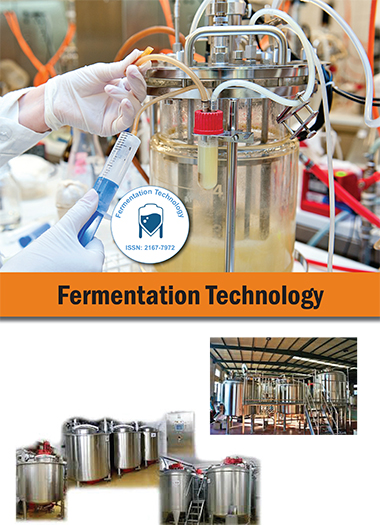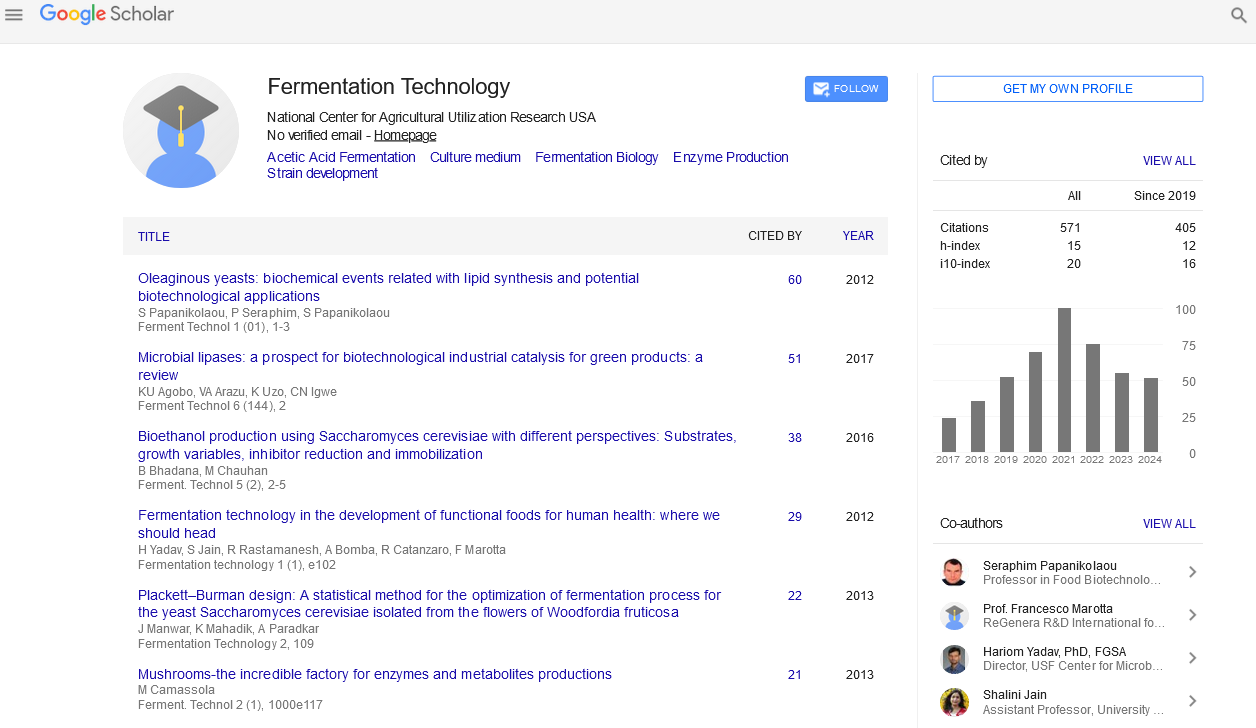Indexed In
- Open J Gate
- Genamics JournalSeek
- Access to Global Online Research in Agriculture (AGORA)
- RefSeek
- Hamdard University
- EBSCO A-Z
- OCLC- WorldCat
- Publons
Useful Links
Share This Page
Journal Flyer

Open Access Journals
- Agri and Aquaculture
- Biochemistry
- Bioinformatics & Systems Biology
- Business & Management
- Chemistry
- Clinical Sciences
- Engineering
- Food & Nutrition
- General Science
- Genetics & Molecular Biology
- Immunology & Microbiology
- Medical Sciences
- Neuroscience & Psychology
- Nursing & Health Care
- Pharmaceutical Sciences
Perspective - (2025) Volume 14, Issue 1
Engineering Metabolic Pathways to Improve Lactic Acid Yield in Batch and Fed-Batch Fermentation Systems
Graeme Dawson*Received: 26-Feb-2025, Manuscript No. FMT-25-29071; Editor assigned: 28-Feb-2025, Pre QC No. FMT-25-29071 (PQ); Reviewed: 13-Mar-2025, QC No. FMT-25-29071; Revised: 20-Mar-2025, Manuscript No. FMT-25-29071 (R); Published: 27-Mar-2025, DOI: 10.35248/2167-7972.25.14.181
Description
Lactic acid is an important organic compound widely used in food preservation, pharmaceuticals, cosmetics and biodegradable plastics such as Polylactic Acid (PLA). Traditionally produced through microbial fermentation, lactic acid synthesis depends heavily on the metabolic capacity of the chosen microorganism and the conditions under which fermentation occurs. In recent years, metabolic engineering has emerged as a key strategy to enhance lactic acid yield by reprogramming microbial pathways.
Microorganisms used for lactic acid production
Lactic acid is produced primarily by Lactic Acid Bacteria (LAB) such as Lactobacillus, Pediococcus and Streptococcus species. Additionally, engineered strains of Escherichia coli, Corynebacterium glutamicum and Saccharomyces cerevisiae have been developed to overcome limitations associated with native LAB, such as pH sensitivity, product inhibition and nutrient demands.
Selection of the appropriate strain depends on desired isomer specificity (L(+)-lactic acid vs. D(−)-lactic acid), substrate utilization and tolerance to high acid concentrations.
Metabolic pathway engineering strategies
Lactic acid production in most microbes is a result of glycolysis, where glucose is converted to pyruvate and subsequently reduced to lactic acid by Lactate Dehydrogenase (LDH). Enhancing this conversion is a key focus in metabolic engineering. Several strategies have been employed:
Overexpression of LDH genes: Increasing the expression of native or heterologous LDH enzymes can improve the flux from pyruvate to lactic acid, increasing overall yield.
Knockout of competing pathways: Eliminating genes involved in the production of by-products such as ethanol, acetate and formate helps channel more carbon toward lactic acid. This has been demonstrated in E. coli by deleting genes such as adhE, pta and pflB.
Redox balancing: Maintaining a balanced NADH/NAD+ ratio is essential for optimal LDH activity. Engineering cofactor regeneration systems can stabilize redox states and improve lactic acid synthesis under both aerobic and anaerobic conditions.
Utilization of non-glucose sugars: Lignocellulosic hydrolysates contain a mix of sugars, including xylose and arabinose. Engineering pathways to metabolize these sugars expands the range of usable feedstocks and increases the overall yield from biomass.
Batch vs. Fed-batch fermentation systems
Fermentation mode plays an important role in lactic acid productivity. Batch fermentation is simple and widely used for small-scale production, but it suffers from substrate inhibition and pH drop due to lactic acid accumulation. In contrast, fed-batch fermentation allows gradual substrate addition, maintaining optimal sugar concentrations and controlling the fermentation environment.
Batch fermentation: In batch systems, all nutrients are supplied at the start. Metabolically engineered strains must withstand rapid acid accumulation and osmotic stress. Some engineered microbes are capable of producing over 90 g/L lactic acid in batch mode when optimized for tolerance and productivity.
Fed-batch fermentation: This strategy supports higher product concentrations by feeding substrates incrementally. Engineered strains with enhanced metabolic fluxes and reduced by-product formation can achieve lactic acid titers exceeding 120 g/L under fed-batch conditions. The feeding rate, timing and composition must be carefully managed to avoid catabolite repression and ensure consistent microbial activity.
Process optimization
In addition to genetic modifications, process parameters such as pH, temperature, aeration and nutrient availability are optimized to support high yield fermentation. Buffer systems or pH control using calcium carbonate or ammonia solutions is commonly applied to maintain a stable environment.
Low-cost substrates such as molasses, starch hydrolysates and food waste are being tested with engineered strains to reduce production costs. In such cases, strain engineering is also aimed at improving substrate versatility and tolerance to impurities.
Downstream processing and purification
Lactic acid produced during fermentation must be recovered and purified to meet industrial standards. The choice of purification method—precipitation, solvent extraction, membrane filtration—depends on the fermentation broth composition and desired product purity.
Metabolically engineered strains that minimize color, odor and protein contamination in the broth simplify downstream steps and reduce overall purification costs.
Environmental and commercial impact
The demand for bio-based lactic acid is rising, particularly with the growth of the PLA market. Metabolic engineering offers a sustainable route to meet this demand by improving conversion efficiency and reducing reliance on energy-intensive chemical synthesis.
Combined with advances in fermentation technology, engineered microbes now enable cost-competitive lactic acid production at commercial scale using renewable substrates.
Conclusion
Engineering microbial metabolic pathways has significantly advanced the field of lactic acid production. By redirecting cellular fluxes and eliminating competing reactions, researchers have developed strains capable of high-yield fermentation in both batch and fed-batch modes. When integrated with optimized process conditions, these advancements promise scalable, efficient and environmentally compatible production of lactic acid for diverse applications.
Citation: Dawson G (2025). Engineering Metabolic Pathways to Improve Lactic Acid Yield in Batch and Fed-Batch Fermentation Systems. Ferment Technol. 14:181.
Copyright: © 2025 Dawson G. This is an open-access article distributed under the terms of the Creative Commons Attribution License, which permits unrestricted use, distribution and reproduction in any medium, provided the original author and source are credited.

